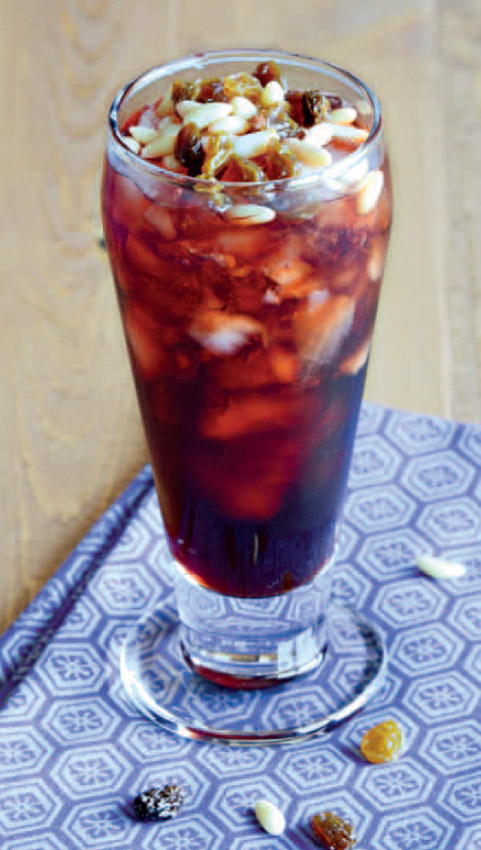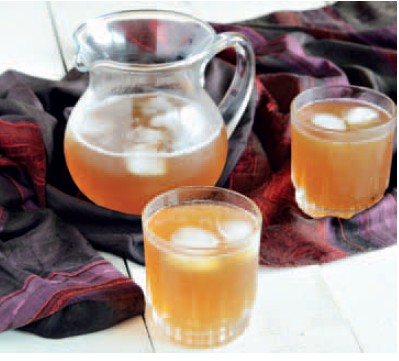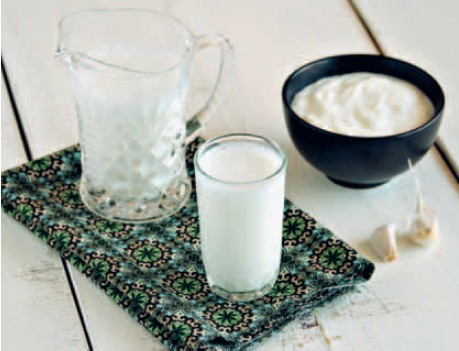A great amount of detail goes into every aspect of Middle Eastern cuisine; even drinks get the attention they deserve. Beverages in Middle Eastern culture have significance; when a guest arrives they are immediately offered a beverage to show your hospitality toward them (and for the guest, it's customary to accept, lest your host think you' re rejecting his hospitality!). Also, during the holy month of Ramadan, when you can’t eat or drink all day, special care is taken to make a delicious drink to be enjoyed at sunset when you can break your fast, the Apricot Drink (Qamar al Deen) on page 138, is a Ramadan favorite. Because of the hot climate, many drinks are served iced, like the Fresh Limeade (Limonada) (page 136) and Grape Syrup Drink with Sultanas and Pine Nuts (Jallab) on page 134), but a great variety of teas and coffees are also enjoyed, such as Sage Tea (Shai Maramieh) on page 138, Turkish Coffee ((Qaweh Turkiyeh) on page 139, and White Coffee (Qahweh Bayda) on page 139.
Grape Syrup Drink with Sultanas and Pine Nuts
JALLAB

Jallab is a kind of syrup flavored mainly with grape molasses, dates, and rose water; the really interesting thing is that it’s smoked with incense, which lends a smoky, spicy flavor to the drink. Instead of attempting to smoke the syrup, I add a few spices and infuse it with a smoky tea, Lapsang Souchong (if you can’t find this, one or two drops of Liquid hickory Smoke Flavor will work…but use it sparingly, since it’s very potent!).
Once the syrup is made, it’s diluted with water and topped with crushed ice, sultanas, and pine nuts for a refreshing treat.
Yields 6 servings
Preparation Time: 5 minutes
Cooking Time: 20 minutes
¼ cup (55 g) chopped pitted dates
½ cup (125 ml) grape molasses
¾ cup (185 ml) water
1 teaspoon looseleaf Lapsang Souchong tea
One (2 in/5 cm) cinnamon stick
2 pods cardamom, bruised
2 whole cloves
1 tablespoon rose water
5 cups (1.25 liters) cold water (or more to taste)
Crushed ice for 6 glasses
6 tablespoons sultanas (golden raisins)
6 tablespoons pine nuts
1 Combine the dates, grape molasses, ¾ cup (185 ml)of water, tea, cinnamon stick, cardamom and cloves in a medium saucepan over medium heat. Bring to a boil, then turn the heat down to simmer and cook until it is syrupy and reduced by about half, about 10 to 15 minutes, stirring frequently. While cooking, occasionally mash the dates against the inside of the saucepan with the back of a wooden spoon. Stir in the rose water.
2 Strain the syrup through a fine mesh sieve, pressing gently with the back of a wooden spoon to extract all the liquid; cool to room temperature. (if you’re not using it right away, store the syrup in the fridge up to 2 months before diluting it with water.)
3 Mix the syrup with 5 cups of cold water, adding more water as desired. Line a mesh sieve with a coffee filter and place it inside a bowl; strain the drink, collecting the liquid in the bowl below.
4 Fill 6 glasses with crushed ice and pour in the drink; top each glass with 1 tablespoon of sultanas and 1 tablespoon of pine nuts.
SAHLAB
Sahlab is a starchy powder made from dried orchids that is used to make creamy, rich drinks or puddings. Sahlab can be a difficult ingredient to find outside turkey where it is harvested, as the orchids it is derived from are becoming rare. Sahlab powder mix, which is typically a mixture of cornstarch, sugar, and flavorings, can usually be found in Middle Eastern grocery stores; if you can’t find this mix you can substitute cornstarch with a bit of orange blossom water.
In drink form, sahlab is thick and comforting…the perfect way to warm up on a cold winter day. If you prefer to make it as a pudding, increase the sahlab powder mix to ¹⁄ ³ cup (50 grams) and keep all other amounts the same; eat the pudding hot, or cool to room temperature and then refrigerate and serve chilled.
Serves 4
Preparation Time: 5 minutes
Cooking Time: 10 minutes
4 cups (1 liter) milk
2 tablespoons plus 2 teaspoons sahlab powder mix (or 2 tablespoons plus 2 teaspoons cornstarch and ½ teaspoon orange blossom water)
4 tablespoons sugar
1 tablespoon shelled pistachios, finely chopped
1 tablespoon unsweetened, desiccated coconut
A couple of pinches of cinnamon
1 Measure out ¼ cup (65 ml) of milk; whisk it together with the sahlab powder in a small bowl.
2 whisk together the remaining milk, sahlab /milk mix, and sugar in a medium, heavy-bottomed saucepan. Bring to a boil over medium heat, whisking frequently; boil 2 minutes, whisking constantly.
3 Pour into 4 individual serving glasses and sprinkle the pistachio, coconut, and cinnamon on top; serve immediately.



LIMONADA
On a hot summer day, it doesn’t get any more refreshing than this. My husband remembers his mom making this for him in the throes of summer, sometimes freezing it until it had a semi-frozen icy texture, similar to italian Granita.
Serves 8
Preparation Time: 10 minutes
1 batch Scented Sugar Syrup (page 28)
1½ cups (375 ml) fresh lime juice (from about 10-12 Persian limes)
6 cups (1.5 liters) water (more or less to taste)
Sliced lime or fresh mint sprigs (optional, for garnish)
1 Prepare the Scented Sugar Syrup and stir together with the lime juice, and water in a large pitcher.
2 Serve chilled garnished with sliced lime or fresh mint, if using.

Rose Syrup Punch
SHARAB AL WARD
This fragrant syrup is used to make a very unique drink; maybe not surprisingly, it is much more a favorite with women than men.
Yields a little over 1 cup (250 ml) of syrup
Preparation Time: 2 minutes
Cooking Time: 10 minutes
1 cup (225 g) sugar
½ cup (125 ml) water
½ tablespoon fresh lemon juice
¼ cup (65 ml) rosewater
¼ teaspoon pomegranate molasses for coloring
1 Add the sugar, water, and lemon juice to a medium, thick-bottomed saucepan, and bring it to a boil over medium heat, giving the pan an occasional swirl and skimming off any foam on the surface.
2 turn the heat down and simmer for 5 minutes, stirring occasionally. Add the rose water, turn heat up to moderately high, and cook for 2 minutes more.
3 turn off the heat and stir in pomegranate molasses. Cool to room temperature and then store in the fridge.
4 to serve, dilute with cold water to taste (about 1 to 2 tablespoons of syrup per 1 cup/125 ml of water); add ice if desired.
ASEER TAMAR HINDI
Tamarind, which literally means “indian Date,” has a complex sweet and sour flavor that is generally more sour than sweet. This drink is incredibly refreshing with a taste reminiscent of lemonade, but with many more subtle flavor notes.
Yields 3 cups (750 ml) of syrup
Preparation Time: 35 minutes, plus 12 hours for the tamarind to soak
Cooking Time: 20 minutes
½ cup (200 g) tamarind paste, cubed if in block form
4 cups (1 liter) water
2 cups (450 g) sugar
1 Combine the tamarind paste and water in a medium bowl and let it sit for 12 hours.
2 Bring the tamarind paste and the water it was soaked in to a boil in a medium saucepan over high heat; boil for 5 minutes, skimming off any foam from the top. Cool 30 minutes, then strain the liquid through a fine mesh sieve lined with cheesecloth, squeezing the cheesecloth to extract all the liquid.
3 Bring the strained liquid and sugar to a boil in a medium saucepan over medium heat; turn the heat down and simmer 5 minutes.
4 Cool the syrup to room temperature, then store refrigerated.
5 to serve, dilute with cold water to taste (about a 1:1 ratio) and pour over ice.

Tangy Yogurt Drink
LABAN AYRAAN
If you’re not used to this drink, the first time you have it will likely make you pucker. Drink on though, because it gets better with each sip. This drink is salty with a refreshing tang; although garlic is optional, it gives the drink great flavor. It’s usually enjoyed with heavy meals like Spiced Shawarma Chicken wraps (page 92) or Roasted Chicken with Flatbread (page 97) since it’s thought to settle the stomach.
Serves 2
Preparation Time: 2 minutes
2 cups (500 ml) plain yogurt
1 cup (250 ml) water
½ teaspoon salt
2 cloves garlic (optional)
1 Blend all ingredients in a blender or food processor.
2 Serve chilled.

QAMAR AL DEEN
I remember being in my mother-in-law’s Syrian kitchen and seeing stack upon stack of apricot leather. This is a common sight in the Middle East, where apricots are frequently preserved by being made into leather or jam. Apricot leather can be used to make drinks, puddings, or eaten as candy, but this recipe is a favorite. This drink is very thick, with a refreshing sweet/tart flavor.

Serves 4
Preparation Time: 10 minutes, plus 2 to 12 hours for the apricot leather to soak
3 cups (750 ml) hot water
3 tablespoons sugar
½ lb (250 g) apricot leather (qamar al deen) or dried apricots, torn or chopped into pieces
1 teaspoon orange blossom water (optional)
Ice cubes (optional, for serving)
1 Combine the water and sugar in a large measuring cup with a pour spout, stirring until the sugar is completely dissolved.
2 Put the apricot leather into a large bowl and pour the sugar water on top. Cover, and let sit 2 to 12 hours, stirring occasionally.
3 Pour the apricot leather and water into a blender or food processor and purée with the orange blossom water, if using; strain through a fine mesh sieve.
4 Refrigerate until chilled; serve with ice, if using.
Sage Tea SHAI MARAMIEH
Tea in the Middle East is rarely drunk as is. Instead, herbs, spices, and/or flowers like jasmine, mint, or sage are used to flavor it. Sage tea is particularly useful to drink after a meal, as it is said to soothe the stomach and aid digestion.
Serves 2
Preparation Time: 1 minute
Cooking Time: 5 minutes
2 cups (500 ml) water
1 teaspoon dried sage leaves
2 teaspoons sugar
1 black tea bag
1 Pour the water and sage into a small pot; bring to a boil over medium-low heat, stirring occasionally.
2 turn off the heat; add the sugar and stir until fully dissolved.
3 Add the black tea and steep 2 minutes.
4 Strain the tea to remove sage leaves; serve.
QAWEH TURKIYEH
In the Middle East, two methods of coffee brewing are commonly used: the traditional Arabic method, which is generally reserved for special occasions, and the turkish method, which is for everyday coffee. For more information, see Serving Coffee the Middle Eastern way (page 15) and Middle Eastern Coffee Pot (page 16).
Turkish coffee is strong, rich, and velvety smooth. To make it, roasted coffee beans are ground into a fine powder with green cardamom, which gives the coffee a very distinctive flavor and aroma. The coffee is boiled with water in a special pot, and then served in very small demitasse cups, known as fenajeen (singular, finjan). The grinds aren’t filtered out; rather, the dregs settle to the bottom of the cup.
Certain foods or dishes have symbolic significance across the world and coffee is the perfect example of this. In the Middle East, coffee is served to guests toward the end of their visit. It’s basically a nice way for the host to ask the guests to leave without having to say it in so many words. A few years ago when Mike and I were staying with his family in Syria, there was a guest that showed up unannounced for a visit. As custom goes, my mother- and sister-in-law served him all manner of teas and sweets in what seemed like an endless procession of food. All the while Mike and I (and the rest of his family) were waiting for the guest to leave, since we had previous plans that had been interrupted. After a couple hours of eating, drinking, and talking, I pulled Mike aside and asked him how much longer he thought the guest would stay; Mike told me that his mom was making coffee, and he explained that coffee signifies to the guest that it’s time to leave. And he was right, the guest was gone within the half hour.
Serves 4
Preparation Time: 1 minute
Cooking Time: 8 minutes
1½ cups (375 ml) water
2 teaspoons sugar (more or less to taste)
2-3 tablespoons Turkish-ground coffee (to taste)

1 Add the water to a 2-cup (500 ml) turkish coffee pot; bring to a boil over high heat.
2 Stir in the sugar and bring it back up to a boil.
3 Stir in the coffee off the heat, then reduce heat to low and cook until the coffee foams up, gently stirring the coffee at the top of the pot constantly. Use a spoon to scoop some of the foam off the top and transfer to the serving cups, if desired.
4 Remove from the heat and gently stir the coffee at the top until the foam goes down, then put it back on the heat and let it foam up a second time, stirring constantly.
5 Remove from the heat and stir until the foam goes down, then put it back on the heat for 3 seconds.
6 Serve immediately.
White Coffee
QAWEH BAYDA
This elegant, perfumed drink, which actually isn’t coffee at all, is perfect for sipping with sweets after dinner.
Serves 2
Preparation Time: 2 minutes
Cooking Time: 5 minutes
2 cups (500 ml) water
A couple of small pieces of orange peel (optional)
2 teaspoons sugar
4 teaspoons orange blossom water
1 Pour the water into a small pot and add the orange peel, if using; bring to a boil over medium-low heat, stirring occasionally.
2 turn off the heat; add the sugar and stir until fully dissolved.
3 Stir in the orange blossom water.